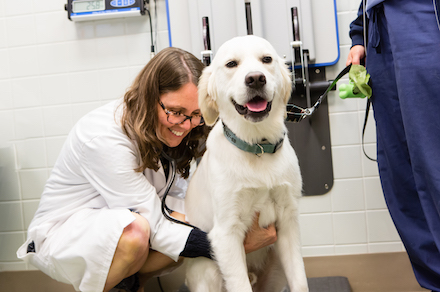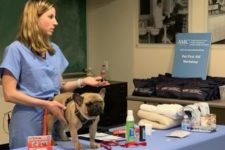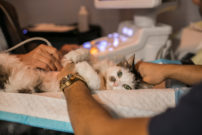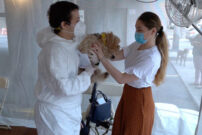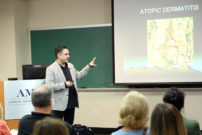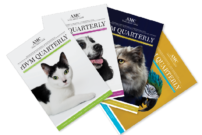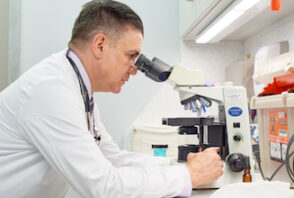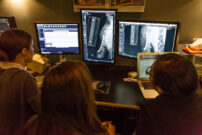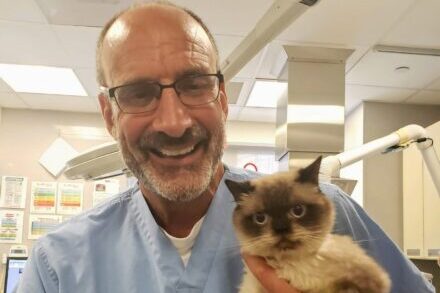Rabbit Care Guide
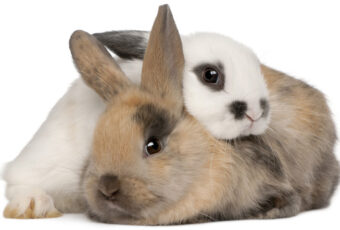
Background
Pet rabbits are descended from the European wild rabbit, Oryctolagus cuniculus. There are well over 50 breeds, including giant, medium, and dwarf breeds. Rabbits are classified as lagomorphs, not rodents, because of the presence of an extra set of upper incisors called “peg” teeth. Both the incisors and molars continue to grow throughout a rabbit’s life. Rabbits are herbivores and feed continuously. In the wild, rabbits primarily eat grasses. Digestion in rabbits occurs mainly in the hindgut (cecum), and this high fiber grass maintains normal gastrointestinal activity and fermentation. It is normal for rabbits to eat their “soft” stools (cecotropes) during the night. These re-ingested fecal pellets provide important proteins and vitamins.
Nutrition
Recommended daily diet (for each 5 pounds of body weight):
• Unlimited Grass Hay (timothy, orchard grass, Bermuda grass)
• Alfalfa hay is not recommended for adult house rabbits as it is too high in calcium and calories.
• Alfalfa hay can be offered as a daily choice to young rabbits.
• Trusted brands of hay include Oxbow and Farmer Dave’s Pet Supply, among others.
• Ideally, adult rabbits should eat 1st cut hays, as they are higher in fiber.
• Leafy Greens and Vegetables (1-4 cups daily)
• Feed low-calcium veggies such as romaine lettuce, red and green leaf lettuces, beet greens,
large carrot pieces and carrot tops, endive, green peppers, raspberry leaves, pea pods (not
the peas), squash and radicchio.
• Avoid or feed only limited amounts of high calcium vegetables such as kale, dandelion,
collards, turnips, parsley, and basil.
• Limit high sugar foods such as baby carrots.
• High fiber Pellets
• Give 1/4 cup- 1/2 cup maximum per day of a Timothy-based pellet for adult rabbits.
• Recommended brands include Oxbow and Supreme Select.
• Young rabbits should be fed an alfalfa-based pellet until 6-8 months of age.
• Limited fruit
• If not overweight, a very small amount of low-sugar fruit is okay, totaling no more than 1-2 teaspoons daily, including melon, raspberry, papaya, blueberry, blackberry, strawberry, and pineapple.
• Avoid sugary fruits such as banana and grapes.
• No high fat or carbohydrate treats
• Do not feed cereals, breads, oats, corn, seeds, nuts, or rabbit treats with sugar or corn syrup in them.
Common Diseases and Illnesses
Gastrointestinal Stasis: GI stasis (abnormal motility) is the number one problem in pet rabbits and is the most common cause of decreased appetite in an otherwise healthy rabbit. An improper diet is the primary cause and may be exacerbated by stress. Rabbits that have fine fur and are heavy shedders are also at increased risk. Rabbits with stasis will have a decreased number of fecal pellets, small, and/or soft stools. In very rare cases, acute death from abnormal fermentation and bacterial growth (enterotoxemia) occurs.
Diarrhea: Diarrhea can develop secondary to GI stasis or as a separate syndrome. Diarrhea is usually a result of bacterial overgrowth. True diarrhea needs to be discerned from an overproduction or decreased ingestion of cecotropes; in this case, there will be periods of normal stool production interspersed with very soft stool.
Dental Disease: Dental problems are very common and caused by several factors, including an improper diet, tooth root infection, and genetics. Rabbit teeth grow 4-5 inches a year and will often overgrow and develop tooth root abscesses, spurs, points, and abnormal wear. Rabbits with dental disease will often stop eating certain foods, such as pellets, have a decreased appetite and may drool.
Obesity: Obesity is common in pet rabbits and is due to an improper diet and lack of exercise. Obesity can lead to lameness and sores on their feet, inability to groom, and GI stasis.
Rabbit hemorrhagic disease virus 2 (RHDV2): Rabbit hemorrhagic disease virus 2 (RHDV2) is a highly contagious and usually fatal virus that affects both wild and domestic (“pet”) rabbits. The virus can be transmitted not only from rabbit to rabbit, but via food, bedding, or other contaminated materials. A vaccine is now available to protect against the virus. It is given in two doses, approximately 21 days apart. A rabbit is considered fully vaccinated 14 days after the second dose.
Upper Respiratory Disease/ Conjunctivitis: Upper respiratory infections (snuffles) manifest as sneezing, ocular and nasal discharge, and difficulty breathing. These infections are usually caused by bacteria, with Pasteurella multocida as one of the most common causes. Chronic infections can be associated with infection of the middle or inner ear, causing head circling and loss of balance.
Vestibular Disease (head tilt): Head tilt in rabbits is usually caused by one of two diseases: bacterial infection of the ear (otitis) or infection with Encephalitozoon cuniculi, a microscopic parasite that infects the brain. In both diseases, rabbits can show either a mild head tilt or severe circling or inability to stand.
Urogenital Disease: Kidney disease occurs in older rabbits and may be caused by infections, toxins, cancer, or infection with Encephalitozoon cuniculi. Uterine tumors are very common in older, unspayed females. Urinary infections and urinary stones can occur from excess calcium secretion from an improper diet.
Recommended Veterinary Care
Yearly Physical Exams:
• Dental examination
• Weight determination and nail trim
• Review diet
• Baseline bloodwork in mature rabbits 1-2 years old
• Spay at 6-9 months; neutering of male rabbits is optional
Signs of Illness
• Decreased or loss of appetite
• Decreased or absence of stools
• Diarrhea
• Discharge from eyes or nose
• Abnormal swelling on the jaw
• Lameness
• Difficulty breathing
• Head shaking
• Head tilt/difficulty hopping
• Skin mass
Make an Appointment






